Spectrophotometric color analysis of maxillary permanent central incisors in a pediatric population: a preliminary study
Abstract
Background
Although several studies have reported the color distribution of maxillary central incisors and the effects of age and gender, a reliable database of the color of newly erupted teeth with open apices and the effect of the root development stage on tooth color shades do not currently exist.
Aim
The purpose of this in vivo study was to perform a spectrophotometric color analysis of maxillary permanent central incisors based on apical developmental stage, age, and gender groups.
Design
A total of 734 maxillary permanent central incisors from 367 children aged 7–18 years who have fully erupted, intact, unrestored, vital right and left maxillary central incisors were evaluated. The patients were divided into nine groups, according to the root development stage and age. Digital images were quantified by non-contact spectrophotometry to determine the tooth color. Each tooth's color shade and L*, a*, and b* values were recorded. The L*, a*, and b* values were analyzed statistically with a multivariate analysis of variance test, and the color shades were analyzed with chi-square tests at the α = 0.05 level.
Results
The most common general tooth shade, for both genders, was A2. A statistically significant difference was found between the 7- to 12-year-old and 13- to 18-year-old age groups in the general tooth shade and its L* value in the overall, cervical, middle, and incisal sites (P < 0.05).
Conclusion
There is a strong relationship between the apical developmental stages of the teeth and the L* values.




